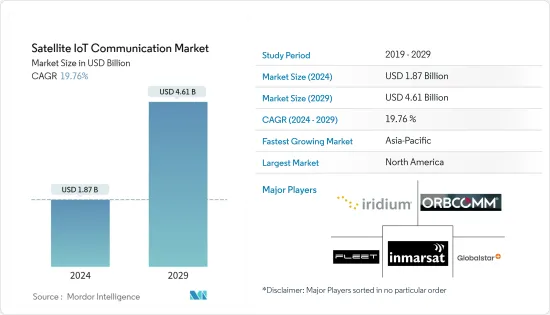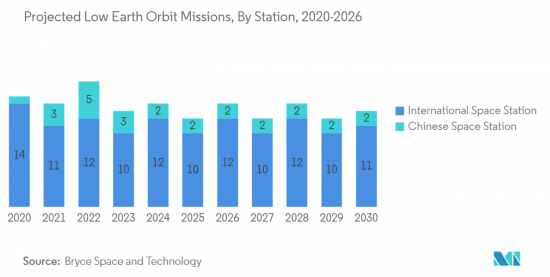
|
市場調査レポート
商品コード
1408172
衛星IoT通信:市場シェア分析、産業動向と統計、2024~2029年の成長予測Satellite IoT Communication - Market Share Analysis, Industry Trends & Statistics, Growth Forecasts 2024 - 2029 |
||||||
カスタマイズ可能
適宜更新あり
|
|||||||
| 衛星IoT通信:市場シェア分析、産業動向と統計、2024~2029年の成長予測 |
|
出版日: 2024年01月04日
発行: Mordor Intelligence
ページ情報: 英文 120 Pages
納期: 2~3営業日
|
- 全表示
- 概要
- 目次
衛星IoT通信市場規模は2024年に18億7,000万米ドルと推定され、2029年には46億1,000万米ドルに達すると予測され、予測期間(2024~2029年)のCAGRは19.76%で成長します。

衛星通信は、遠隔地における地上セルラーネットワークや非セルラーネットワークを補完し、様々な産業アプリケーションに恩恵をもたらします。5Gエコシステムは、衛星と地上ネットワークをシームレスに統合する上で重要な動向となります。
主要ハイライト
- 衛星通信の推進力は、モノのインターネット(IoT)機器の世界接続に対する差し迫ったニーズから生じています。この分野のいくつかの企業は、特にSmallSatコンステレーションのイントロダクションよって、衛星通信のアプリケーションの拡大に投資しています。いくつかの企業は、インテリジェントなデータ転送のために機器を監視・追跡するために衛星IoTサービスを利用しています。
- 世界の衛星モノのインターネット通信市場は、5G無線接続の開発と成長によって牽引されています。SAT 5G(欧州連合が支援する5GPPPプロジェクト)やメトロ・イーサネット・フォーラム(MEF)など、LEO衛星を介した5G接続を拡大する取り組みが活発化した結果、双方のオープンで標準化されたエコシステム間でより多くの相互作用が求められるようになっています。安全で異機種混合の衛星・地上5Gネットワークの構築は、通信事業者とLEO衛星プロバイダーがサービスをよりよく統合する助けにもなります。
- LEO衛星市場への大規模な投資は、衛星IoT通信市場の成長を後押しする重要な側面です。この投資は、適応性、安価なコスト、高度なメカニクス、組み立てと打ち上げの簡素化、大量生産、短いライフサイクルによって後押しされており、今後数年間の市場成長を促進すると思われます。
- さらに、産業分野で自律システムやコネクテッドデバイスを採用する傾向が強まっていることも、市場調査にプラスの影響を与えています。エリクソンによると、2028年末までにセルラーIoT接続のほぼ60%がブロードバンドIoTになると予測され、4Gがその大半を占める。これは、予測期間を通じて市場が成長・強化するための十分な機会を生み出すと思われます。
- 宇宙空間の極端な温度は、市場を抑制する重大な要因です。衛星は宇宙の過酷な環境にさらされているため、衛星内に収容されている電子部品は極端な温度によって脅かされます。そのため衛星は、通信に影響が出ないよう、システム障害を避けるために動作可能な温度を維持しなければならないです。
- COVID-19パンデミックは、世界中のあらゆる産業に衝撃を与えました。衛星IoT通信分野にも大きな影響を与えました。この分野は、災害時の通信やバックアップ・サービスに不可欠な衛星通信サービスの高い信頼性と耐久性など、いくつかの分野で政府との契約に依存しているため、世界のパンデミックのより深刻な影響から守られている可能性があります。しかし、パンデミックの後、地上接続サービスへのアクセスが増加しており、衛星IoT通信に大きな機会が残されています。
衛星IoT通信の市場動向
低軌道(LEO)が衛星IoT通信の成長を牽引
- 地球上空160~2000kmを周回する低軌道(LEO)衛星コンステレーションは、地上がカバーされていない孤立した地域、サービスが行き届いていない地域、遠隔地への5G接続を拡大する上で潜在的に魅力的です。地表の約10%しか地上接続サービスを利用できないため、LEO衛星を利用した衛星IoT通信には大きな機会が残されています。
- LEO衛星は、その適応性、手頃な価格、高度なメカニクス、組み立てと打ち上げの容易さにより、大手企業から多額の投資を集めています。衛星のライフサイクルは短く、大量生産されます。政府機関や、小売・銀行・石油・ガスなどの商業部門では、低コストで高速なインターネットへの需要が大きいです。また、新興国の個人消費者の間では、農村部でのインターネット・アクセスの必要性が、LEOコンステレーションへの投資を促進しています。
- LEOは低電力通信に適しており、信号伝搬損失が小さいため、ユーザー機器の電力要件を低減し、低電力IoT機器との接触に理想的です。現在、IoT向けのLEO衛星のほとんどは、主にCubeSat技術を活用して構築されており、企業は部品を大量生産し、市販の部品を提供できるため、衛星の設計・開発にかかるコストと時間を大幅に削減できます。衛星IoT通信サービスを開始する既存の衛星通信事業者やニュースペース新興企業にとって、これは望ましい選択肢となっています。
- さらに、消費者ベースを拡大し、さまざまな用途にわたる需要によりよく応えるために、重要な企業も投資、他事業との合併、新規プロジェクトへの投資を行っています。例えば、2023年4月、5G-IoT標準の低軌道(LEO)超小型衛星コンステレーションを運用する最初の企業であるSateliot社は、モノのインターネットへのアクセスを民主化するため、史上初の5G標準のLEO衛星であるSateliot_0「The GroundBreaker」を発表しました。
- 2023年2月、米国を拠点とするRivada Networks, Inc.の完全子会社であるRivada Space Networks GmbH(RSN)は、Terran Orbitalの完全子会社であるTyvak Nanosatellite Systems, Inc.に、Rivadaの革新的な"空のネットワーク"用の低軌道(LEO)衛星300基の製造を委託しました。RSNの宇宙ベースのデータ・ネットワークは、ファイバー並みの低遅延とギガビット/秒のデータ配信を提供し、超高セキュリティで非常に弾力性があります。

北米が最大のシェアを占める見込み
- 北米は衛星IoT通信市場で大きなシェアを占めています。この成長は、軍事と通信ネットワークに対する政府支出の増加に起因しています。Honeywell International, Inc.、General Dynamics Corporation、L3Harris Technologies Corporationなど、主要な参入企業が存在することが、この地域の市場成長を大きく牽引しています。
- 5Gネットワークは、政策立案者や政府が都市をスマートシティに変貌させ、住民が先進的でデジタル、データ集約型の経済から社会経済的利益を得て、参加できるようにする上で重要な役割を果たします。その結果、当局は、衛星IoT通信市場の需要を満たすために努力するファイバーネットワークやデータセンターなどの受動的資産の構築とアップグレードが必要になります。
- さらに、政府、農業、鉱業、エネルギー、海事、航空などのエンドユーザー産業からの需要の増加は、この地域における市場の成長を強化しています。さらに、同地域ではネットワーク接続が改善され、技術インフラの足場が整っています。例えば、2022年8月、InmarsatとhiSkyは、接続性を向上させながら、IoT採用者にコスト効率の高いサービスを提供する新しいスケーラブルIoTソリューションを構築しました。
- 2023年6月、Qualcomm Technologies, Inc.は、衛星通信機能を備えた2つのモデムチップセット(Qualcomm 9205S ModemとQualcomm 212S Modem)を発表しました。Qualcommの新しいモデムチップセットは、主に、スタンドアロンの非地上ネットワーク(NTN)接続または地上ネットワークとのハイブリッド接続を必要とするオフグリッド産業用ユースケースをサポートし、IoT開発者、企業、OEM、とODMが、特にさまざまなビジネスプロジェクトを管理するために重要なリアルタイム情報と洞察を活用できるようにします。
- また、Iridium Communications Inc.は2022年12月、Iridium Messaging TransportSM(Iridium Messaging TransportSM)のサービス開始を宣言しました。これは、主にイリジウム・サータス上での使用に最適化され、衛星接続を既存または新規のIoTソリューションに簡単に組み合わせることができるように構築された、双方向のクラウドネイティブ・ネットワーク・データ・サービスです。IMTは、衛星IoTアプリケーションを支援する小規模から中規模のメッセージ向けに構築された、イリジウム・ネットワーク独自のIPデータ・トランスポート・サービスを提供します。Iridium CloudConnectとAmazon Web Servicesと統合された新サービスは、様々な新しいIridium ConnectedツョョIoTデバイスの開発コストと市場投入までの時間を最小限に抑えることができます。
衛星IoT通信業界概要
衛星IoT通信市場は競争が激しく、Astrocast、Inmarsat Technologies、Kepler Communications、Ligado Networks、Galaxy Space、Geelyなど複数の大手企業で構成されています。現在、市場シェアで市場を独占しているのは一部の大手企業のみです。突出した市場シェアを持つこれらの大手企業は、海外における顧客基盤の拡大に注力しています。これらの企業は、市場シェアと収益性を高めるために、戦略的な共同イニシアティブを活用しています。主要発展には次のようなものがあります。
2023年3月、世界のIoTソリューション・プロバイダーであるQuectel Wireless Solutionsは、IoT通信とソリューションの世界的プロバイダーであるORBCOMMが提供する衛星IoT接続を使用するIoT産業向けCC200A-LB衛星モジュールを発売しました。このモジュールは主に、信頼性の高い世界の接続性とカバレッジを、費用対効果の高い価格帯と超低遅延で提供するために構築されています。このモジュールは、輸送、海上、重機、鉱業、農業、石油・ガス監視など、広範なアプリケーションに最適なソリューションです。
世界の衛星と地上ネットワーク・ソリューション・プロバイダーであるマーリンクと、地球低軌道(LEO)5G IoT衛星通信会社であるOQ技術は、既存のセルラーネットワークと互換性があり、3gpp 5g非地上ネットワーク・セルラー規格に基づく衛星5Gコネクティビティとハードウェアの販売に向けた世界の販売パートナーシップに関するMoUを締結しました。
T-Mobile USとStarlinkは、衛星からデバイスへの直接接続を開発する技術提携を発表しました。同様に、米国のOmnispaceは、フィリピンの携帯電話会社Smart社(PLDTの子会社)と協力し、Smartの5GネットワークとOmnispaceのLEO衛星との相互運用性を、3GPP準拠の5G NTN規格を用いて検討しました。
その他の特典:
- エクセル形式の市場予測(ME)シート
- 3ヶ月間のアナリストサポート
目次
第1章 イントロダクション
- 調査の前提条件と市場定義
- 調査範囲
第2章 調査手法
第3章 エグゼクティブサマリー
第4章 市場力学
- 市場概要
- 市場促進要因
- 5Gワイヤレス接続の開発と成長
- LEO衛星コンステレーションへの大規模投資
- 市場の課題
- 極端な宇宙温度
- 産業魅力度モデル-ポーターのファイブフォース分析
- 消費者の交渉力
- 供給企業の交渉力
- 新規参入業者の脅威
- 代替品の脅威
- 競争企業間の敵対関係の強さ
- 産業バリューチェーン分析
- COVID-19が文書管理市場に与える影響
第5章 市場セグメンテーション
- 軌道タイプ別
- 地球低軌道(LEO)
- 中軌道(MEO)
- 静止軌道(GEO)
- 地域別
- 北米
- 欧州
- アジア太平洋
- その他
第6章 競合情勢
- 企業プロファイル
- Iridium Communications Inc.
- Orbcomm
- Inmarsat Global Limited
- Globalstar Inc
- Fleet Space Technologies Private Limited
- Viasat, Inc
- Cobham Limited
- Boeing
- L3Harris Technologies
第7章 投資分析
第8章 市場機会と今後の動向

The Satellite IoT Communication Market size is estimated at USD 1.87 billion in 2024, and is expected to reach USD 4.61 billion by 2029, growing at a CAGR of 19.76% during the forecast period (2024-2029).
Satellite communication complements terrestrial cellular and non-cellular networks in remote locations, which benefits various industrial applications. 5G ecosystems would be a key trend in seamlessly integrating satellite and terrestrial networks.
Key Highlights
- The drive for satellite communications stems from the pressing need for global connectivity for the Internet of Things (IoT) devices. Several businesses in this sector are investing in broadening the applications for satellite communication, most notably with the introduction of SmallSat constellations. Several businesses use satellite IoT services to monitor and track equipment for intelligent data transfers.
- The Global satellite Internet of Things communication market is driven by the development and growth of 5G wireless connectivity. The demand for more interaction between open and standardized ecosystems on both sides is emerging as a result of the growing number of efforts to expand 5G connection via LEO satellites, such as SAT 5G (a 5GPPP project supported by the European Union) and Metro Ethernet Forum (MEF). Building a safe, heterogeneous satellite and terrestrial 5G network would also aid telecom operators and LEO satellite providers better integrate their services.
- Considerable Investments in the LEO Satellite Market are a significant aspect boosting the growth of the satellite IoT Communication Market. The investments have been fueled by adaptability, cheap cost, advanced mechanics, simplicity of assembly and launch, mass production, and short life cycles, which would drive market growth in the coming years.
- Moreover, the growing trend of adopting autonomous systems and connected devices in the industrial sectors positively influences the market studied. According to Ericsson, by the end of 2028, almost 60 percent of cellular IoT connections are forecast to be broadband IoT, with 4G connecting the majority. This would create ample opportunities for the market to grow and enhance throughout the forecast period.
- Extreme Space temperature is a critical factor that could restrain the market. Satellites are exposed to the harsh environment of space, which makes the electronic components housed inside the satellites threatened by extreme temperatures. Hence satellites must maintain operational temperatures to avoid system failures so that communication is not affected.
- The COVID-19 pandemic caused shockwaves across every industry worldwide. It had a significant effect on the satellite IoT communication sector. The sector may be protected from the more severe effects of the global pandemic due to its reliance on government contracts in several areas, including the highly dependable and durable nature of satellite communications services, which are essential for disaster communications and backup services. However, there has been an increasing rise in access to terrestrial connectivity services after the pandemic, which left a significant opportunity for satellite IoT communications.
Satellite IoT Communication Market Trends
Low Earth Orbit (LEO) drives the Growth of the Satellite IoT Communication
- Low-Earth Orbit (LEO) satellite constellations, which orbit between 160 and 2000 kilometers above the Earth, are potentially attractive for expanding 5G connectivity to isolated, underserved, and remote geographies where terrestrial coverage is absent. Only about 10 % of the Earth's surface has access to terrestrial connectivity services, which leaves a significant opportunity for satellite IoT communications on the LEO constellations.
- LEO satellites attract significant investment from major players due to their adaptability, affordability, advanced mechanics, and ease of assembly and launch. The satellites have a short lifecycle and are mass-produced. There is a significant demand for low-cost, high-speed internet in the government and commercial sectors like retail, banking, oil, and gas. Also, the need for internet access in rural areas among individual consumers in emerging countries is driving investments in LEO constellations.
- LEO are better suited to low-power communications and lower signal propagation losses, reducing the user equipment's power requirements and making it ideal for contact with low-power IoT devices. Today, most of the LEO satellites for IoT are built mainly for leveraging CubeSat technology, allowing companies to mass-produce components and provide commercial off-the-shelf parts, drastically reducing the cost and time to design and develop satellites. It has become the desired option for incumbent satellite operators and NewSpace start-ups launching satellite IoT communication services.
- Moreover, to increase their consumer base and better meet their demands across various applications, significant companies are also investing, merging with other businesses, and investing in new projects. For instance, in April 2023, Sateliot, the first company to operate a low-Earth orbit (LEO) nanosatellite constellation with 5G-IoT standard, introduced Sateliot_0 "The GroundBreaker," the first-ever 5G standard LEO satellite, to democratize access to the Internet of Things.
- In February 2023, Rivada Space Networks GmbH (RSN), an entirely owned subsidiary of U.S.-based Rivada Networks, Inc., engaged Terran Orbital's wholly owned subsidiary Tyvak Nanosatellite Systems, Inc. to manufacture 300 low-earth-orbit (LEO) satellites for Rivada's innovative "network in the sky." RSN's space-based data network will provide fiber-like low latency and gigabit-per-second data delivery which is ultra-secure and extremely resilient.

North America is Expected to Hold Largest Share
- North America holds a significant share of the Satellite IoT Communication market. The growth is attributed to the growing government spending on military and communication networks. The presence of key significant players, such as Honeywell International, Inc., General Dynamics Corporation, L3Harris Technologies Corporation, and many others, drive the market growth significantly across the region.
- 5G networks play a vital role in assisting policymakers and governments in transforming cities into smart cities, allowing inhabitants to participate and realize socioeconomic benefits from an advanced, digital, data-intensive economy. As a result, authorities would be required to build and upgrade passive assets, such as fiber networks and data centers, which strive to meet the demand for the satellite IoT Communication Market.
- Moreover, the rise in the demand from end-user industries, such as government, agriculture, mining, energy, maritime, and aviation, is enhancing the market growth in the region. Moreover, the region has improved network connectivity and advanced foothold technological infrastructure. For instance, In August 2022, Inmarsat and hiSky created a new scalable IoT solution to provide a cost-efficient offering to IoT adopters while improving connectivity.
- In June 2023, Qualcomm Technologies, Inc. declared two modem chipsets with satellite capability: the Qualcomm 9205S Modem and the Qualcomm 212S Modem. The new Qualcomm modem chipsets primarily power off-grid industrial use cases that need a standalone non-terrestrial network (NTN) connectivity or hybrid connectivity alongside terrestrial networks and enable IoT developers, enterprises, OEMs, and ODMs to harness the key real-time information and insights especially to manage various business projects.
- Also, in December 2022, Iridium Communications Inc. declared the service launch of Iridium Messaging TransportSM, a two-way cloud-native networked data service primarily optimized for use over Iridium Certus and built to make it easier to combine satellite connections to the existing or new IoT solutions. IMT delivers an IP data transport service unique to the Iridium network, built for small-to-moderate messages assisting satellite IoT applications. Integrated with Iridium CloudConnect and Amazon Web Services, the new service can minimize the development costs and the speed time to market for various new Iridium Connected® IoT devices.
Satellite IoT Communication Industry Overview
The satellite IoT communication market is highly competitive and consists of several major players, such as Astrocast, Inmarsat Technologies, Kepler Communications, Ligado Networks, Galaxy Space, and Geely. Only some significant players currently dominate the market in terms of market share. With a prominent market share, these major players focus on expanding their customer base across foreign countries. These companies leverage strategic collaborative initiatives to increase their market share and profitability. Some of the key developments are:-
In March 2023, Quectel Wireless Solutions, a worldwide IoT solutions provider, launched the CC200A-LB satellite module for IoT industries that uses satellite IoT connectivity offered by ORBCOMM, a worldwide provider of IoT communications and solutions. The module is mainly built to deliver reliable global connectivity and coverage at a cost-effective price point and with ultra-low latency. It is a perfect solution for a vast spectrum of applications, including transportation, maritime, heavy equipment, mining, agriculture, and oil and gas monitoring.
Marlink, a global satellite and terrestrial network solution provider, and OQ Technology, the low Earth orbit (LEO) 5G IoT satellite communications company, signed an MoU for a global distribution partnership towards the distribution of Satellite 5G connectivity and hardware that is compatible with an existing cellular network and based on the 3gpp 5g non-terrestrial network cellular standard.
T-Mobile US and Starlink announced a technology partnership to develop a direct satellite-to-device proposition, which was expected to launch by 2024. Similarly, US-based Omnispace collaborated with the Philippines' mobile operator Smart, a subsidiary of PLDT, to explore interoperability between Smart's 5G network and Omnispace's LEO satellites, using 3GPP-compliant 5G NTN standards.
Additional Benefits:
- The market estimate (ME) sheet in Excel format
- 3 months of analyst support
TABLE OF CONTENTS
1 INTRODUCTION
- 1.1 Study Assumptions and Market Definition
- 1.2 Scope of the Study
2 RESEARCH METHODOLOGY
3 EXECUTIVE SUMMARY
4 MARKET DYNAMICS
- 4.1 Market Overview
- 4.2 Market Drivers
- 4.2.1 Development and Growth of 5G Wireless Connectivity
- 4.2.2 Considerable Investments in the LEO Satellite Constellations
- 4.3 Market Challenges
- 4.3.1 Extreme Space Temperature
- 4.4 Industry Attractiveness Model - Porter's Five Forces Analysis
- 4.4.1 Bargaining Power of Consumers
- 4.4.2 Bargaining Power of Suppliers
- 4.4.3 Threat of New Entrants
- 4.4.4 Threat of Substitute Products
- 4.4.5 Intensity of Competitive Rivalry
- 4.5 Industry Value Chain Analysis
- 4.6 Impact of COVID-19 on the Document Management Market
5 MARKET SEGMENTATION
- 5.1 By Type of Orbit
- 5.1.1 Low Earth Orbit (LEO)
- 5.1.2 Medium Earth Orbit (MEO)
- 5.1.3 Geostationary Orbit (GEO)
- 5.2 By Geography
- 5.2.1 North America
- 5.2.2 Europe
- 5.2.3 Asia-Pacific
- 5.2.4 Rest of the World
6 COMPETITIVE LANDSCAPE
- 6.1 Company Profiles
- 6.1.1 Iridium Communications Inc.
- 6.1.2 Orbcomm
- 6.1.3 Inmarsat Global Limited
- 6.1.4 Globalstar Inc
- 6.1.5 Fleet Space Technologies Private Limited
- 6.1.6 Viasat, Inc
- 6.1.7 Cobham Limited
- 6.1.8 Boeing
- 6.1.9 L3Harris Technologies


